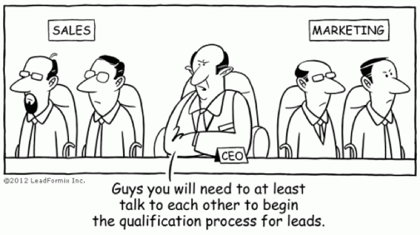
Quick poll: Marketers, when was the last time you sat down with your company’s sales team to discuss quarterly priorities and action plans?
What do you mean you don’t remember?
It seems counter-intuitive that sales and marketing have traditionally sat at separate tables. After all, these functions have the exact same long-term objective – to drive revenue and sustainable business growth. And according to recent research by Forrester, 50% of marketers (and 48% of CFOs) are focusing on “better connecting marketing with the sales forecasting process to help build pipeline.”
So how’s that working out at your financial services organisation?
Maybe all marketers think salespeople do is talk on the phone and go for expensive lunches. Maybe all salespeople think all we do is make pretty websites and post memes on social media.
Maybe our short-term motivators have been too different. Maybe marketers (this includes PR and advertising folk) have been focusing on the wrong metrics all this time: clicks, engagement, coverage numbers, brand awareness, blah blah… when we should have been holding ourselves accountable to the actual new business we played a part in bringing in all along. AKA ROI.
Back to basics. I could talk about how modern marketing works by attracting traffic to a company’s website using content through various distribution channels, capturing some of that traffic as leads, then nurturing those leads until they’re sales-ready.
Instead, I like to think of the whole process as fishing. Marketing starts off by analysing the waters, and trying our best to understand the fish, where it swims and what it really wants. Then we carefully craft some tasty, tasty bait, choose our fishing spot and rods and zealously cast our line out. We wait for a bite, and when we feel a good tug, we pass it on to sales, whose job is to REEL IT IN.

That’s an ideal scenario. What happens when marketing and sales don’t talk to each other? Half of sales’ time is spent on fishing in empty waters (AKA unproductive prospecting), with sales ignoring as much as 80% of bites (leads) from marketing (according to research by Marketo and ReachForce). That means a WHOLE lot of time and effort wasted.

But when sales and marketing do work well together, businesses are 67% better at closing deals.
So how to make sure your company’s sales and marketing teams are aligned?
- Start from your overarching business strategy
Sales and marketing should sit down together and talk about things like:
What types of fish do we want to catch?
How many fish do we need this trip to feed our village?
Where can we find the best fish?
What are the forecasted water conditions? Any stormy areas to watch out for?
Am I willing to brave these storms to catch the prized blue fin tuna?
By being involved in this process together, sales and marketing can collaboratively decide on their common goals, strategic focus and KPIs for the upcoming period, and marketing can support sales by tailoring our content and materials to nudge the sales team’s target market down the funnel.
- Clearly define and agree marketing to sales handoff
There’s nothing worse than getting excited about the prospect of having a good catch on the line, spending hours and all your energy wrestling with it, then finally pulling it up to reveal… an old boot.
Not all leads are going to be immediately sales-ready. That’s why it’s important to define and agree between the two departments what makes a marketing-qualified lead (MQL). What constitutes a hard enough tug that signals the prospect can now be contacted by a BDM?
Marketing automation platforms (like Hubspot, Adobe Marketo, Pardot) offer lead scoring functionalities that help marketers judge when the lead has shown enough buying signals through interactions with our content. For example, someone might have downloaded your eBook ‘Are you Financially Ready to Retire?’ then opened your newsletter when you emailed it to them, and clicked on your Retirement Income Calculator tool. Each of these interactions can be assigned a score, and when the agreed score has been reached, the lead is marked as qualified and can be handed over to sales for follow up – and the BDM can shape their conversation around what they know the prospect is interested in.
All this can be documented formally with a Service Level Agreement (SLA) between sales and marketing (free template here). According to research by Hubspot, companies with an active SLA are 34% more likely to experience greater year-on-year ROI than companies without.
- Joint activities
A large part of marketing’s job is crafting bait. When marketing knows what sort of fish are best for the business and which sales wants to catch, we can make our bait more valuable and therefore attractive to those fish. As the marketing team produces a new content offer, it should involve the sales team’s input at the beginning of the process and also their help once it’s ready to distribute the offer through their networks, helping it reach its intended audience. An easy way of doing this is having a shared content calendar including agreed responsibilities for ideation and distribution.
Marketing and sales should also share a common CRM/database that’s consistently updated by both teams. This way, information about each contact and behavioural data are visible from either end.
Marketers can ghost-write content for salespeople, which helps to establish their profile and authority within their space. We can also help salespeople with using social media for business purposes, for example providing training on networking through LinkedIn.
It might not feel natural at first, but an internal culture of sharing and collaboration can be fostered when we are proactive about it. Because when sales and marketing work hand-in-hand, we catch the best fish.

(They were probably right about the memes.)
BlueChip Communication’s marketing team works closely with our financial services clients’ sales teams to support them and help them achieve our common objectives – driving revenue and positive business outcomes.











